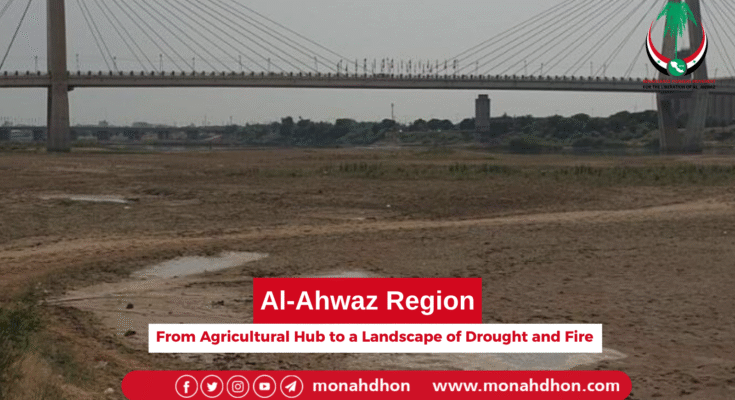Monahdhon
The AL-Ahwaz region, historically one of Iran’s agricultural and industrial hubs, has been facing a deep-rooted and widespread water crisis for years — a crisis that is not merely environmental, but profoundly political and discriminatory. Repeated droughts, diminished flow from historic rivers such as the Karkheh and Karun, extensive dam construction, and large-scale water transfer projects to Iran’s central regions — all compounded by deliberate mismanagement of water resources — have turned this land into one of the country’s most critical hotspots.
This crisis is not the wrath of nature, but rather the result of a deliberate and discriminatory policy that prioritizes large-scale industrial projects and the interests of specific institutions over support for rural and indigenous communities. Within this framework, the Arab population of AL-Ahwaz has repeatedly protested the lack of drinking water, the drying of palm groves, and power outages during the scorching summers — protests that have met with harsh repression and institutionalized violence. One clear example is the “Uprising of the Thirsty” in the summer of 2021 (1400 in the Iranian calendar), which was met with bullets and batons.
The Islamic Republic’s Official Policy: Management or Control of the People?
Across the last three administrations of the Islamic Republic, particularly under the 13th and 14th governments, promises have been made to combat drought: from advanced water supply technologies and pressurized irrigation systems to reducing evaporation and upgrading water transfer networks. But in practice, these promises translated into prioritizing projects that serve military institutions, industries, and central cities — not local farmers, marginalized Arab communities, or the palm growers loyal to their land.
The allocation of resources to oil, steel, and petrochemical industries — without regard for agricultural and environmental water rights — reveals that the Islamic Republic’s water policies are not aimed at balanced development, but rather at cementing control and denying the existence of the AL-Ahwaz region.
The Hoor al-Azim Fires: A Sign of Natural Collapse
From last winter through the current summer, more than 22,000 hectares of Hoor al-Azim — the largest wetland in southwest Iran and the region’s respiratory lung — have been engulfed in flames. Drought caused by cutting off water rights has turned the wetland into a field of dry, flammable reeds. Thick smoke now hovers over cities such as AL-Ahwaz, Hoveyzeh, Meysan (Dasht-e Azadegan), and Khafajiyeh (Susangerd), disrupting the lives and breathing of residents.
In response to this disaster, authorities have done little more than send a single inefficient water bomber, repeating empty promises without taking any serious steps to restore the wetland’s natural water share.
The Palm Groves of Abadan: Burning the Roots of Life
In the final days of July 2025 (Tir 1404), deadly flames swept through the palm groves of Abadan. Areas like Manyuhi, Kut-Shanouf, Abu Oqab, and Abu Shakr witnessed one of the most devastating fires of the past decade. Reports estimate that 15,000 to 20,000 fruit-bearing palm trees — symbols of life and livelihood — were destroyed by fire. Four homes and one workshop were also completely ruined.
Local residents correctly identified the main causes: dry land, lack of agricultural water, and the absence of firefighting infrastructure — a truth that the responsible authorities have ignored or deflected. The absence of a functioning fire station in such a vital area is yet another symbol of structural discrimination.
Drought and Fire: Two Sides of One Policy
In the AL-Ahwaz region, drought and fire are not separate events; they are two manifestations of the same policy — one that has either plundered or abandoned the region’s vital resources, pushing the environment toward total collapse. When water rights for wetlands are ignored, and fire stations are neglected, what follows is not a mere fire, but the orchestrated destruction of a people.
This drought is not natural; it is imposed. The burning of wetlands and palm groves is not just climate change — it is the result of inequality, exclusion, and a politically driven strategy to silence an entire region.
Beneath the Surface of Discrimination: Silence vs. Justice
As long as water transfer projects to Isfahan, Yazd, and Qom take precedence, and steel plants and power stations in Al-Ahwaz consume unlimited water, any mention of “water justice” is a bitter joke.
As long as the Arabs of AL-Ahwaz are deprived of piped water while industrial complexes in the heart of the desert are well supplied, this cannot be called anything but environmental racism and systemic discrimination.
The water and fire crisis in AL-Ahwaz is no longer a technical or environmental issue; it has become existential. The discriminatory water policies, coupled with willful neglect of environmental protection infrastructure, are turning a thriving region into a silent desert.





